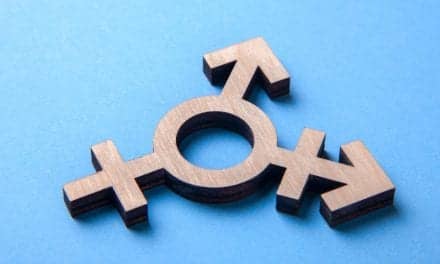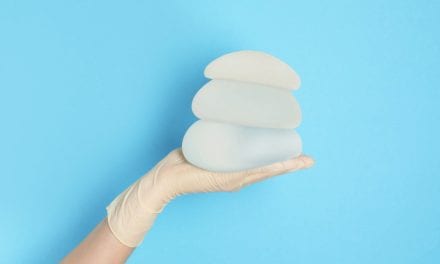Last March, in the wake of an FDA update on breast implant-associated anaplastic large cell lymphoma (BIA-ALCL) — and the ensuing media firestorm — we dissected the facts and figures surrounding the disease to contextualize the actual risk breast implants may pose.
To recap, BIA-ALCL is not breast cancer. It’s an extremely rare type of non-Hodgkin’s lymphoma — a cancer of the cells of the immune system — that can affect those possessing both a genetic predisposition and textured breast implants. (Unlike smooth-shelled implants, textured ones have an irregular surface that acts like Velcro, which helps keep them from changing position.) While researchers don’t fully understand the link between implants and BIA-ALCL, “we believe the disease arises as a result of a long-term inflammatory reaction to probable bacterial contamination, particularly in the presence of textured implants, which present more interstices for bacterial adhesion,” explains Adam Kolker, an associate clinical professor of surgery at the Icahn School of Medicine in New York City. Simply put: the nooks and crannies comprising textured shells can be ripe for germ colonization.
While doctors and patients in the U.S. overwhelmingly prefer the natural feel of smooth implants — they’re used in 87 percent of surgeries — textured implants do offer distinct advantages for certain people. “The main reason many surgeons choose textured implants is because they are also shaped [rather than round],” says Lara Devgan, an attending plastic surgeon at Lenox Hill Hospital and Manhattan Eye, Ear & Throat Infirmary. With a teardrop appearance that mimics the silhouette of a natural breast, shaped implants only come with clingy textured shells, because “even a small degree of rotation can cause them to look askew,” she adds. They can be preferable in breast-reconstruction surgeries following mastectomies, as they give form where there is none, and they’re often used to “correct size and shape deformities,” says Kolker. They’re also beloved abroad, being used in 90 percent of augmentation cases in Europe and Australia.
That said, an American woman’s risk of developing BIA-ALCL lies between 1 in 30,000 and 1 in 50,000. “BIA-ALCL can develop years — two to 20 or more — following breast-implant surgery, and can present as a new swelling of the breast, a lump, or fluid collection around the implant,” says Kolker. (The lymphoma cells are generally found in the fluid surrounding an implant, or in what’s called the capsule, a smooth, soft sheath of normal scar tissue that forms around an implant.) BIA-ALCL is not difficult to diagnose, notes Kolker, and with an accurate and timely diagnosis, cure rates are currently 100 percent.
According to data from the American Society of Plastic Surgeons (ASPS), the American Society for Aesthetic Plastic Surgery (ASAPS), and the International Society of Aesthetic Plastic Surgery (ISAPS), there are more than 30 million women with textured breast implants globally. And, to date, there have been 12 BIA-ALCL deaths worldwide — the majority “resulting from misdiagnoses, late diagnoses, or improper treatment,” says Rian Maercks, a plastic surgeon in Miami and New York City.
Two New Studies Reality-Check the Risk
New research is now rekindling — and generously informing — the BIA-ALCL conversation. Aiming to undercut recent sensationalism, a study in the Aesthetic Surgery Journal (ASJ) calculates the precise risk of dying from BIA-ALCL using a micromort analysis. A micromort is a measure of relative risk. One micromort is equal to a one-in-one-million chance of death. The authors found that, for a woman with two textured breast implants, the risk of dying from BIA-ALCL is .4 micromorts. Which likely means very little to the average patient — until her doctor provides crucial context: The micromort risk from drinking two glasses of wine, or simply living two days in New York City, is two-and-a-half times higher than the micromort risk from having breast implants. Traveling eight hours by car carries a 40 times higher micromort risk. According to study co-author William P. Adams, Jr., an associate professor of plastic surgery at UT Southwestern Medical Center in Dallas, the micromort of BIA-ALCL is so comparatively low, scientists are pushing to have the disease reclassified as a lymphoproliferative disorder rather than an actual lymphoma, which bears a much higher micromort. “A lymphoproliferative disorder is a reactive condition with a spectrum of progression to cancer,” Adams says. “The majority are benign, but in the end stages, they can become true lymphomas.”
A second article, published online last month in the ASJ, presents a peer-reviewed analysis of five 10-year FDA studies conducted by three U.S. breast-implant manufacturers (Allergan, Mentor, and Sientra) on the long-term safety of both textured and smooth implants. Beyond elucidating the pros and cons, the report explores the various types of textured-shell surfaces produced by each company via its own specific manufacturing technique. The authors state, “The unique characteristics of the different implants mandate that we consider each textured device on its own merit, and avoid generalizing all textured implants as one in the same.” Mentor’s implants have more of a “microtexture” — think fine-grit sandpaper as opposed to the coarser “macrotexture” of Allergan’s (Sientra’s implants are a mix of micro- and macrotextures). As Maercks explains, “We know that large texturing is one requirement [for ALCL] and theories exist that the friction caused by macrotexture, the increased surface area and potential for bacterial colonization, and the tendency to have silicone particulate shed may all contribute to inducing this disease.” In fact, the study notes that 70.3 percent of BIA-ALCL cases were associated with Allergan’s implants (both saline and silicone).



